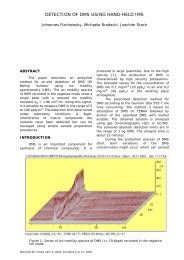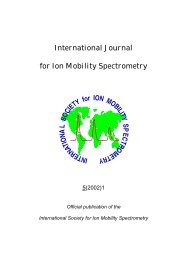Miniature DMS-IMS detector for enhanced revolving power Abstract ...
Miniature DMS-IMS detector for enhanced revolving power Abstract ...
Miniature DMS-IMS detector for enhanced revolving power Abstract ...
You also want an ePaper? Increase the reach of your titles
YUMPU automatically turns print PDFs into web optimized ePapers that Google loves.
IJ<strong>IMS</strong> 10(2007)1 - 5<br />
<strong>Miniature</strong> <strong>DMS</strong>-<strong>IMS</strong> <strong>detector</strong> <strong>for</strong> <strong>enhanced</strong> <strong>revolving</strong> <strong>power</strong><br />
E.G. Nazarov * , A.G. Anderson * , E.V. Krylov * , S. L. Coy * , R.A. Miller * , D. Burchfield @ ,<br />
and G. A. Eiceman#<br />
* Sionex Corporation, Bed<strong>for</strong>d, MA<br />
@ Hamilton Sundstrand, Pomona, CA.<br />
# New Mexico State University, Las Cruces, NM.<br />
<strong>Abstract</strong><br />
Ion mobility based gas analyzers provide high sensitivity detection and identification of<br />
trace levels of ions in gases. Because these analyzers operate at ambient pressure, they<br />
are of reduced complexity and suitable <strong>for</strong> field applications. However, dealing with the<br />
real world complexity of mixtures, field applications continue to be a challenge.<br />
Currently there are two types of ion mobility based gas analyzers. These are based on<br />
Ion Mobility Spectrometer (<strong>IMS</strong>) and Differential Mobility Spectrometer (<strong>DMS</strong>) technologies.<br />
The two methods operate on different principles of ion separation. In <strong>IMS</strong>, ion<br />
species separation is a function of the coefficient of mobility (K 0 ) of the ions, resulting in<br />
different drift times. In <strong>DMS</strong>, ion separation is a function of the electric-field-dependence<br />
of mobility ((E) parameter). For <strong>enhanced</strong> ion identification it is desirable to use the value<br />
of the comprehensive mobility coefficient, K(E) = K 0 (1+(E)). Combining <strong>DMS</strong> and <strong>IMS</strong><br />
will take advantage of complementary data on a given ion species and enhance chemical<br />
identification.<br />
The new Sionex portable tandem <strong>DMS</strong>-<strong>IMS</strong> instrument includes a <strong>DMS</strong> <strong>for</strong> rapid separation<br />
of positive and negative ions, and two short (1.5cm) <strong>IMS</strong> drift tubes <strong>for</strong> further resolution<br />
of <strong>DMS</strong> pre-filtered ions. The sensor system is compact; measuring only<br />
2"×2.5"×3". The design has been optimized through computer modeling using the<br />
Sionex-proprietary microDMx TM modeling software package. In the tandem system,<br />
<strong>DMS</strong> provides compensation voltage (Vc) separation while the <strong>IMS</strong> provides drift time<br />
separation. Figure 4 shows a <strong>DMS</strong>-<strong>IMS</strong> images <strong>for</strong> positive toluene ions in nitrogen (left<br />
frame, 45ppb) and in air (right frame, 17.5ppb). The right frame shows that in air, toluene<br />
<strong>for</strong>ms four ion species that can be resolved using the tandem system. The current prototypes<br />
have high sensitivity (ppb level) <strong>for</strong> a wide range of chemicals including CWA simulants,<br />
explosives, TICs, TIMs, and environmental pollutants.<br />
Introduction<br />
An ion mobility spectrometer includes stages <strong>for</strong> ionization, ion separation by electric<br />
field and ion current measurement. Ion separation is based on the ion mobility coefficient.<br />
Two main types of ion mobility spectrometers are most popular at present: the low-field<br />
Ion Mobility Spectrometer (<strong>IMS</strong>, Figure 1 top right) and the Differential Mobility Spectrometer<br />
(<strong>DMS</strong> Figure 1 top left). The two devices operate on different principles of ions<br />
separation. In <strong>IMS</strong>, ion species are separated by their coefficient of mobility 1 (K 0 ). In<br />
<strong>DMS</strong> ion species are separated by their field mobility dependence 2 ((E)). Enhance resolving<br />
<strong>power</strong> results if the ion mobility based gas analyzers utilize both K 0 and (E) properties<br />
<strong>for</strong> ion separation. Combining <strong>DMS</strong> and <strong>IMS</strong> 3 takes advantage of the comprehensive<br />
coefficient mobility, K(E) = K 0 (1+(E)). Prototype of Sionex <strong>DMS</strong>-<strong>IMS</strong> 2 tandem system<br />
(Figure 1, bottom) provides this complementary ion in<strong>for</strong>mation.
IJ<strong>IMS</strong> 10(2007)1 - 6<br />
Experimental<br />
The new Sionex portable tandem <strong>DMS</strong>-<strong>IMS</strong> 2 instrument (Figure 2, left) has two steps of<br />
ions separation: on the first, <strong>DMS</strong> provide pre-separation of positive and negative ions<br />
according differential mobility , and then two short (1.5cm) <strong>IMS</strong> drift tubes (one <strong>for</strong> each<br />
ion polarity) provide further separation according absolute value of ion species mobility.<br />
The sensor system is compact, measuring only 2"×2.5"×3". The design has been optimized<br />
through computer modeling using the Sionex-proprietary microDMx TM modeling<br />
software package (Figure 2, right). The <strong>DMS</strong> section provides compensation voltage<br />
(Vc) separation all ion species <strong>for</strong>med in ionization region while the two orthogonal located<br />
<strong>IMS</strong> provide drift time (DT) separation <strong>for</strong> both positive and negative ions simultaneously.<br />
Results and Discussion<br />
Since the trend lines of the mass resolution (Figure 3, left) <strong>for</strong> the <strong>IMS</strong> 1 and <strong>DMS</strong> 4 are<br />
quasi-orthogonal, a <strong>DMS</strong>-<strong>IMS</strong> tandem system has <strong>enhanced</strong> <strong>power</strong> <strong>for</strong> ions specie identification.<br />
Figure 3 ( right frame) shows that the combination in<strong>for</strong>mation obtained in the<br />
first and second steps and presented in two-dimensional space (drift time vs. compensation<br />
voltage) provides the <strong>enhanced</strong> resolving <strong>power</strong> of the <strong>DMS</strong>-<strong>IMS</strong> system. Combined<br />
with possibility to scan of the separation voltage (RF voltage) in the <strong>DMS</strong>, the<br />
analytical space can be extended to three-dimensional, and provide further in<strong>for</strong>mation<br />
related to ions fragmentation too.<br />
Figure 4 shows <strong>DMS</strong>-<strong>IMS</strong> 2-D spectra <strong>for</strong> positive toluene ions in nitrogen (left, 4.5ppb)<br />
and in air (right, 17.5ppb). The left frame shows that in air, toluene <strong>for</strong>ms four ion species<br />
which do not be resolved in each of segments of system, but using the tandem system<br />
all these species can be detected and resolved independently.<br />
Conclusions<br />
<strong>DMS</strong>-<strong>IMS</strong> tandem provides the complementary chemical in<strong>for</strong>mation provided by a<br />
<strong>DMS</strong>-<strong>IMS</strong> tandem systems improves the confidence level <strong>for</strong> detection, separation, and<br />
identification of ion species in real-world situations. The current prototypes have high<br />
sensitivity (ppb level) <strong>for</strong> a wide range of chemicals of current practical interest, including<br />
CWA simulants, explosives, TICs, TIMs, and environmental pollutants.<br />
References<br />
[1] Mason E.A.; McDaniel E.W.; Transport Properties of Ions in Gases. 1988, Wiley, New York.<br />
[2] Buryakov I.A.; Krylov E.V.; Nazarov E.G.; Rasulev U.Kh., Int. J. Mass Spectrom. Ion Proc., 1993,<br />
128, 143-148.<br />
[3] Anderson A.G.; Krylov E.K.; Nazarov E.G.; Miller R.A.; Coy S.L., PITTCON, February 2007,<br />
Chicago, USA, p.59.<br />
[4] Krylov E.; Nazarov E.G.; Miller1 R.A.; Tadjikov B.; Eiceman G.A., Journal of Physical Chemistry A.<br />
2002, 106(22), 5437-5444.
IJ<strong>IMS</strong> 10(2007)1 - 7<br />
Figures<br />
<strong>DMS</strong> = Adjustable Ion Filter<br />
<strong>IMS</strong> = Time-of-Flight Spectrometer<br />
Peak position (CV) depends on {(E); SV} Peak position (DT) depends on {K 0 ; E; L}<br />
<strong>DMS</strong>-<strong>IMS</strong> tandem<br />
Peak position depends on {(E); K 0 ; Vc; E}<br />
Figure 1. Differential Mobility Spectrometer (<strong>DMS</strong>) (top left); drift-tube Ion Mobility<br />
Spectrometer (<strong>IMS</strong>) (top right) and <strong>DMS</strong>-<strong>IMS</strong> tandem (bottom).<br />
Figure 2. Sionex portable tandem <strong>DMS</strong>-<strong>IMS</strong> instrument (left). Optimization tandem<br />
system with microDMx TM modeling software (right).
IJ<strong>IMS</strong> 10(2007)1 - 8<br />
Figure 3. Trend lines of <strong>DMS</strong> and <strong>IMS</strong> mass resolution (left). Simulation of the<br />
combined analytical space of <strong>DMS</strong> and <strong>IMS</strong> based on those trend lines (right).<br />
Figure 4. <strong>DMS</strong>-<strong>IMS</strong> 2-D spectra <strong>for</strong> positive toluene ions in nitrogen (left, 4.5ppb) and<br />
in air (right, 17.5ppb), showing resolution of multiple ions <strong>enhanced</strong> by the extended<br />
analytical space.
















